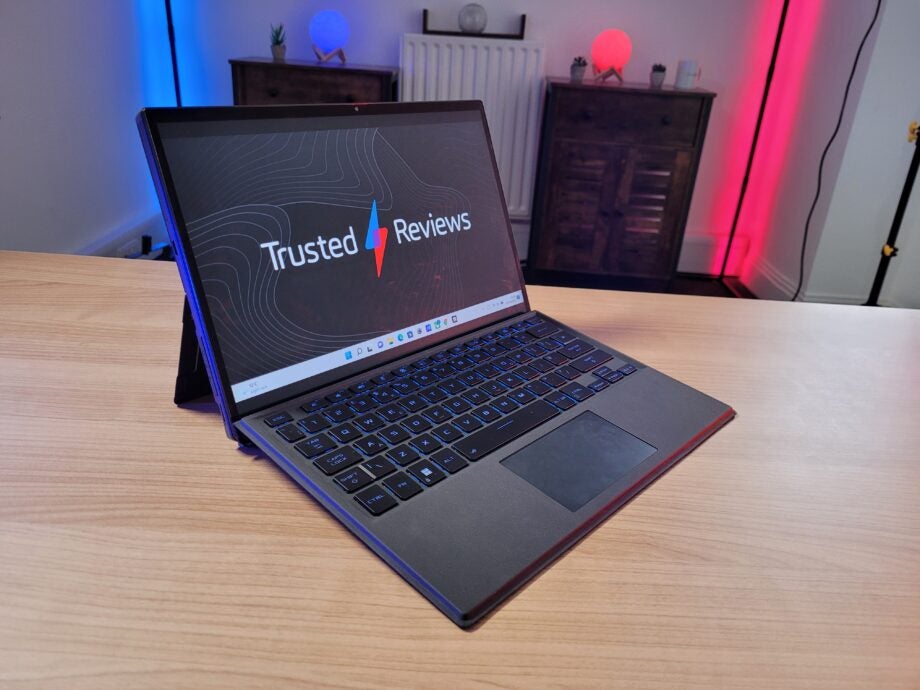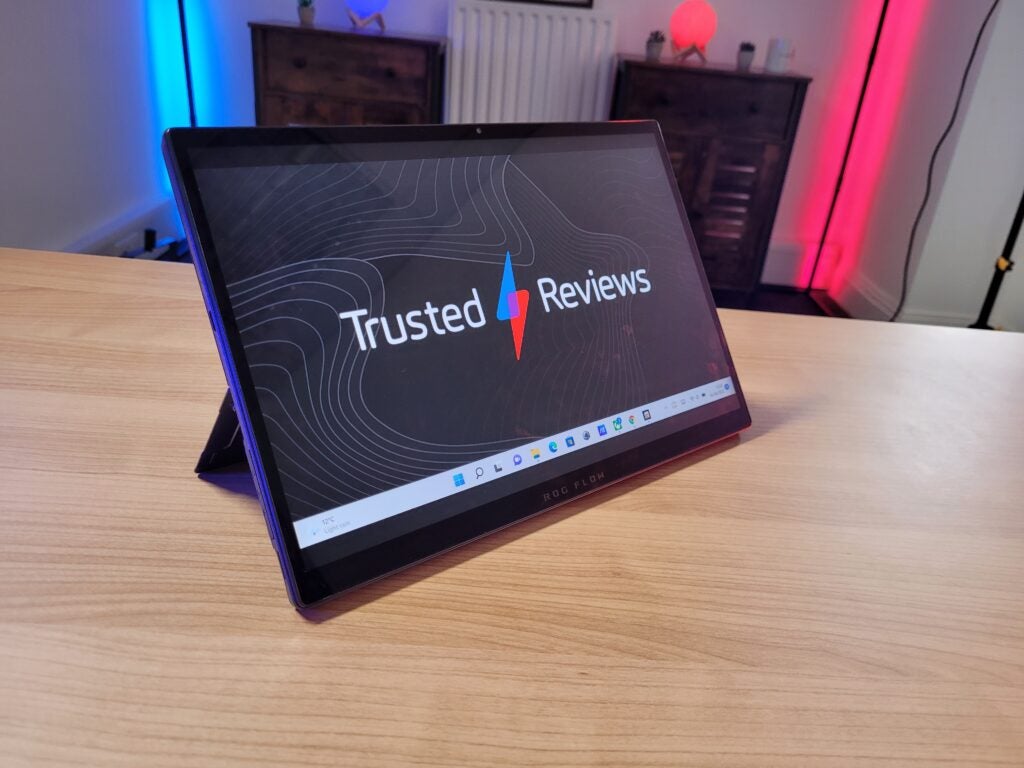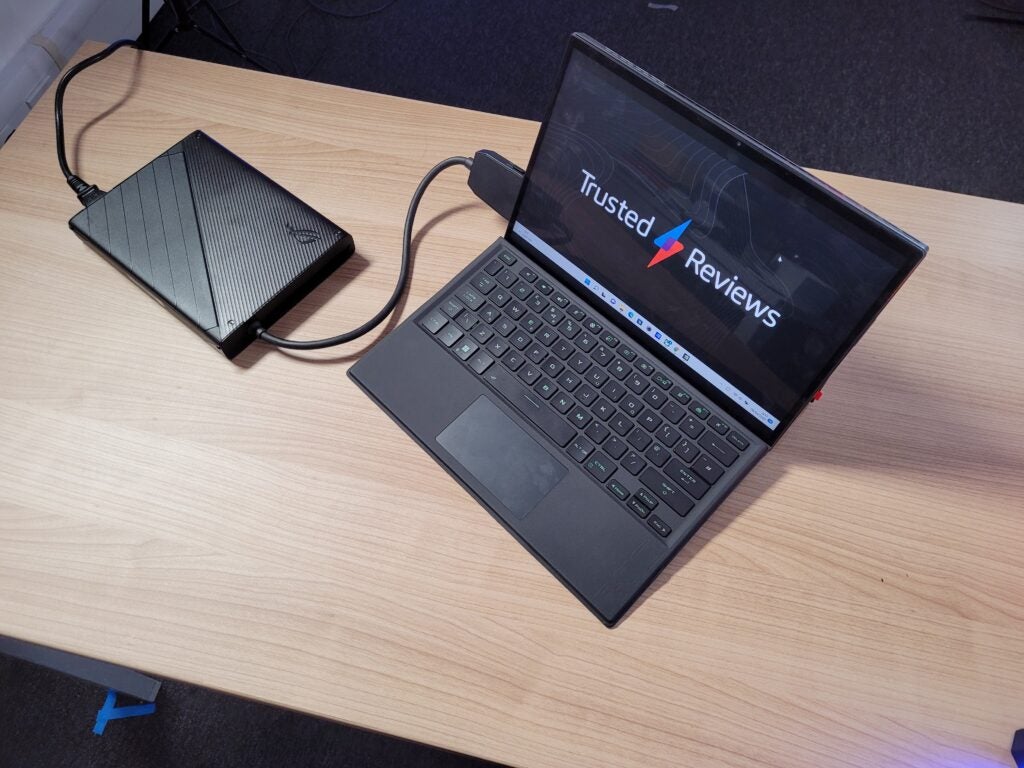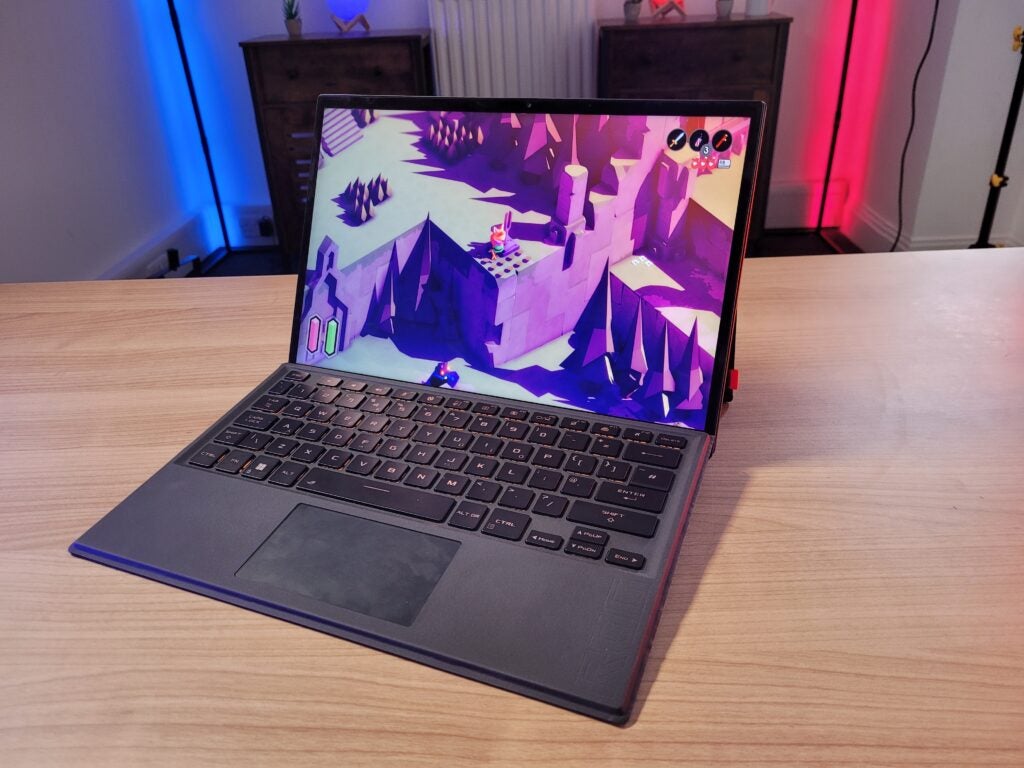Asus ROG Flow Z13 Review
A gaming portable with a Surface Pro design


Verdict
The Asus ROG Flow Z13 takes the design of Microsoft’s Surface Pro, and gives it the power of a gaming PC. It’s an incredibly versatile device, allowing you to play games on the go, or leverage the power of a high-end PC with the optional external GPU. But the poor battery life limits its portability prowess and the sub-standard keyboard isn’t ideal for hardcore gamers, making it a gaming laptop with very niche appeal.
Pros
- Extremely portable with hybrid design
- Great performance for casual gaming
- Superb screen quality
- Option to boost performance with eGPU
Cons
- Poor battery life undermines portability
- Optional eGPU is very expensive
- Type cover is a poor gaming keyboard replacement
Availability
- UKRRP: £1899.99
- USARRP: $1899.99
Key Features
- Hybrid designCan be used as either a tablet or a makeshift laptop thanks to its detachable keyboard.
- Casual gaming performanceCan play the majority of games in 1080p with a smooth 30fps performance.
- Compatible with ROG Mobile XGSupports Asus’ external GPU to leverage the power of an RTX 3080 for an even faster performance.
Introduction
The Asus ROG Flow Z13 is one of the most unusual gaming laptops I’ve ever used – in fact, calling it a laptop feels disingenuous despite its ability to play modern PC games.
Instead, this is actually more of a gaming tablet that comes bundled with a detachable keyboard – think Microsoft’s Surface Pro, but with the power and personality of a gaming laptop. It’s an odd concept that I’m not sure anyone was actually crying out for, but I’ve grown to love it during the testing process.
And while Asus has been forced to compromise on the firepower given the tablet’s slender frame, the company has ensured compatibility with its ROG XG Mobile accessory, which lends the device the firepower of an RTX 3080; one of Nvidia’s most powerful laptop GPUs on the market.
As a result, the ROG Flow Z13 is not only one of the more portable gaming PCs I’ve ever laid eyes on, but it’s also one of the most powerful when bundled with the ROG XG Mobile. Surely there’s a catch? In order to find out, I spent the last two weeks testing the device. Here are my thoughts.
Design
- Hybrid design with detachable keyboard
- Type Cover is good for the basics, but not for gaming
- Poor port selection
The Asus ROG Flow Z13 is a 13.4-inch tablet, making it even bigger than the largest iPad Pro. But it’s not quite as thin as a proper tablet, as its chucky and square edges aren’t the nicest to hold – it looks and feels very much like a laptop screen that’s been ripped off its hinge.
But the ROG Flow Z13 isn’t really intended to be held like a tablet, as it comes bundled with a detachable keyboard, which magnetically clips into the underside of the device in a snap. That’s a relief, as Windows 11 is far better optimised for keyboard use than touchscreen gestures.

There are pros and cons to such a design. Hitting the scales at 1.18kg, this is one of the lightest gaming laptops I’ve ever used, and it was an absolute doddle to carry to and from the office in my bag. But the big trade-off is the bundled type cover – it pales in comparison to a proper gaming laptop keyboard, with its skinny deck and shallow key presses.
When writing up long reviews on the keyboard, the cramped size and shallow keys would cause my hands to cramp. As a result, I wouldn’t recommend people to use it for long essays and the like, but it’s perfectly fine for jotting down notes and navigating the web.
But despite the type cover featuring some cool RGB lighting effects, I certainly don’t recommend using it for gaming, lacking the mechanical crunch that most gamers crave. And that trackpad is far too small and unreliable to be used as an alternative to a gaming mouse.

This is a major pain point for the ROG Flow Z13, as you can’t exactly lug around an external gaming mouse and keyboard all the time. But I did find it enjoyable to use with a game controller. With the device’s built-in kickstand, I was able to prop up the tablet and start using it with an Xbox pad, similarly to how you’d use a Nintendo Switch in tabletop mode. It was a really enjoyable way to play the likes of Elden Ring and Tunic.
That flip-out metal stand has fantastic build quality, and the hinge is sturdy enough to securely hold the tablet in place when propped up on a desk. To be honest, the entire tablet has top-notch build quality. There are some snazzy etchings on the rear that gives the tablet an unmistakable gaming personality – there’s even a glass panel that gives you a sneak peek at the motherboard inside, complete with RGB lighting.

The port offering is a weak point though. There’s only one Thunderbolt 4 (which is used for charging), a single USB-A connection and a headphone jack. This means you’re going to need to buy a USB hub (or use the optional ROG Mobile dock) if you want to connect multiple peripherals and keep it plugged into the mains simultaneously, which isn’t ideal. There’s also a microSD card reader for storage expansion and a ROG XG Mobile Interface that lets the Flow hook up to an external GPU, but more on that later.
You’ll find air vents on the top edge of the tablet, blasting out hot air as you game, while the speakers are situated at the bottom of each side and are capable of producing surprisingly loud and crisp audio. I happily enjoyed playing games on the Flow without bothering with a gaming headset.
Screen
- Vibrant screen is great for gaming
- Very bright display
- Can hike refresh rate up to 120Hz
The ROG Flow Z13 has a 13.4-inch panel with a 16:10 aspect ratio, and two resolution options: 1920×1200 or 3840×2400. I was sent the former, but it still looked dazzling when playing both video and games.
Colours look bold and sharp, especially with the story-book art style of Tunic. Gamers are arguably accustomed to larger screens these days, but I personally didn’t have a problem, especially since I can prop it closer to me when detaching the keyboard.

I used a colorimeter to back up my own impressions. The recorded max brightness of 497 nits is well above the 300-nit average for laptops, and the contrast is respectable at 1346:1. My only concern is the slightly high black level, which means the Flow Z13 struggles for detail when displaying dark imagery, such as exploring a dark cave in Elden Ring.
The colour coverage is superb though, with 96% sRGB coverage which means the Flow can produce accurate colours for digital media such as video games. The high Adobe RGB and DCI-P3 coverage scores even make it a good option for creators working with photos and video.
Asus has smartly opted to hike up the refresh rate to 120Hz for the model with 1200p resolution, allowing it to display fast motion with great detail when the performance is high enough to boost the frame rate beyond 60fps. Unfortunately, you’ll probably need to plug in the external GPU in order to reach that high performance, as the RTX 3050 Ti isn’t exactly the most powerful discrete GPU around.
Performance
- One of the best CPUs we’ve tested
- Built-in GPU only good for casual gaming
- Can be paired with an RTX 3080 eGPU
The ROG Flow Z13 model that Asus sent me packs an Intel Core i9-12900H CPU and an Nvidia RTX 3050 Ti GPU. That’s the most powerful configuration available, as you can downgrade to an Intel Core i5-12500H and Intel Iris Xe graphics, although that will struggle to provide adequate gaming performance.
I can only test the model that Asus sent me, so all of the benchmark results you’ll see will be for the top-range configuration. I used both benchmark software and games to determine the performance of the device, as well as my own impressions for day-to-day use.
First up, the processor is sublime. No matter what workloads you throw at this portable, whether it’s multiple web browsers, juggling intensive apps or playing CPU-intensive games, the Intel chip paced through everything without breaking a sweat.
| ROG Flow Z13 | Razer Blade 14 | Alienware x15 R1 | |
| CPU | Intel Core i9-12900H | Ryzen 9 5900HX | Intel Core i9-11900H |
| Geekbench 5 Single core | 1885 | 1456 | 1610 |
| Geekbench 5 Multi core | 10,665 | 7408 | 9369 |
| PCMark 10 | 6967 | 7017 | 6780 |
The ROG Flow Z13 performed impressively well against other gaming laptops. Despite being a tablet that you can comfortably pick up in one hand, it achieved far better CPU speeds than even the Razer Blade 14, which packs one of AMD’s most powerful laptop chips.
Results aren’t so impressive for the RTX 3050 Ti GPU. This is one of Nvidia’s weakest graphics chips in its latest generation, which showed in the 3D Mark benchmark tests.
| ROG Flow Z13 | ROG Flow Z13 with XG Mobile | Razer Blade 14 | |
| GPU | RTX 3050 Ti | RTX 3080 | RTX 3070 |
| 3DMark Time Spy | 4577 | 10,981 | 8721 |
But Asus has a trick up its sleeve, as the ROG Flow Z13 supports the XG Mobile external GPU, which can lend the laptop the power of an RTX 3080 when plugged into its proprietary port. This suddenly makes the ultra-portable gaming tablet even more powerful than a Razer Blade 14.
Of course, there are caveats here. The XG Mobile is incredibly expensive, adding an extra £1000 to the total price when bundled with the laptop. It also needs to be plugged into a power source to function, and is arguably too large and heavy to carry around on the regular.
Nevertheless, it’s a great option to have as my testing found the XG Mobile to triple the performance of the majority of games. By default, the ROG Flow Z13 achieved an average frame rate of 27fps for Borderlands 3, 61fps for Dirt Rally and 35fps for Horizon Zero Dawn when set to a 1080p resolution. Those results are just about high enough to ensure these games are playable with max graphics settings, but won’t satisfy those who crave fast refresh rates.

Plug the XG Mobile into the Flow, and those results are given a huge boost: 91fps for Borderlands 3, 192fps for Dirt Rally and 99fps for Horizon Zero Dawn – now those are impressive results. Unfortunately, I couldn’t really make the most of this performance increase, as my review sample is limited to a 1200p resolution. The 120Hz refresh rate at least allows you to make use of smoother on-screen action, but the hybrid design of the Flow Z13 is hardly ideal for pro-grade multiplayer gamers.
Another aspect to keep in mind is how hot and loud the XG Mobile can be. I accidentally left a wire too close to its vent, and immediately started to smell burning, which my office’s health and safety officer will no doubt be outraged to hear. And when pushed to the limit, the fan noise can be really distracting, so I’d warn against whipping it out in an office setting.
You can either opt for a 512GB or 1TB capacity for the SSD, which are both plenty big enough to store a large collection of games. The SSD speeds are superb too, with read and write speeds of 3466MB/s and 2311MB/s respectively, which should ensure wicked-fast loading and saving times for both video games and productivity apps.
Battery life
- Can barely last an hour while gaming
- Only 5-hour stamina for productivity apps
The Asus ROG Fow Z13 has a dream design for portable gaming, but there’s one huge drawback for such use: the battery life.
The hybrid gaming portable didn’t even outlast the hour when playing the new RPG Tunic, which is hardly the most demanding game currently available. While I loved propping up the tablet and playing it with my Xbox controller, I’m not sure how useful that portable design is when the battery life can be depleted so quickly.
You could always eke more stamina out of it by turning down the brightness and tweaking the graphics settings, but you’re hardly going to be able to double the battery life.

I also ran a battery benchmark test via PCMark 10, which simulates a variety of day-to-day productivity tasks to see how long the Flow Z13 lasts with regular use. It lasted 5 hours and 8 minutes – that isn’t great, but it’s not atypical for a gaming laptop with a discrete GPU.
You’ll get better battery life by opting for a handheld gaming device like the Steam Deck instead, although the lack of keyboard would mean you’d struggle to use it as a productivity PC like you can with the Flow Z13.
Latest deals
Should you buy it?
You want an ultra-portable gaming PC: The biggest appealing point of the ROG Flow Z13 is its lightweight design, allowing you to easily carry it around in a bag and then prop up on a desk to table for a spontaneous gaming session. I particularly enjoyed pairing it with an Xbox controller and using it like a Nintendo Switch in tabletop mode.
You like to use a keyboard and mouse for gaming: The ROG Flow isn’t the most ideal gaming portable when using a keyboard and mouse. The bundled type cover has shallow key travel, and there aren’t enough ports to connect all the desired peripherals without a USB hub. This is best used with a gamepad controller instead.
Final Thoughts
The Asus ROG Flow Z13 is a fascinating gaming PC, rocking a similar 2-in-1 design as Microsoft’s Surface Pro laptop, but with the graphics grunt to play games on the go. I really enjoyed using this with an Xbox controller, offering a similar experience to a Nintendo Switch in tabletop mode.
The ROG XG Mobile external GPU is also a useful optional extra accessory to super-charge the graphics power, even if it does come with an eye-watering price.
But the Flows’ short battery life limits its use as a gaming portable, while the bundled keyboard type cover is adequate for jotting down notes and browsing the web, but is a poor alternative to a proper gaming keyboard. As a result, there are numerous drawbacks to this hybrid design, giving the unique gaming portable niche appeal.
How we test
Every gaming laptop we review goes through a series of uniform checks designed to gauge key things including build quality, performance, screen quality and battery life.
These include formal synthetic benchmarks and scripted tests, plus a series of real world checks, such as how well it runs when running a AAA game.
Used as our main laptop for at least a week.
Tested the performance via both benchmark tests and real-world use.
We tested the screen with a colorimeter and real-world use.
We tested the battery with a benchmark test and real-world use.
FAQs
Yes, it does have a touchscreen and can function like a tablet.
Trusted Reviews test data
The table below shows the test data we collected reviewing the Asus ROG Flow Z13.
Full specs
You can see a breakdown of the Asus ROG Flow Z13’s full specs in the table below.
Jargon buster
2-in-1
A laptop with a 180-degree hinge, which allows you to twist the screen to the back of the keyboard, shifting the laptop into a makeshift tablet.








